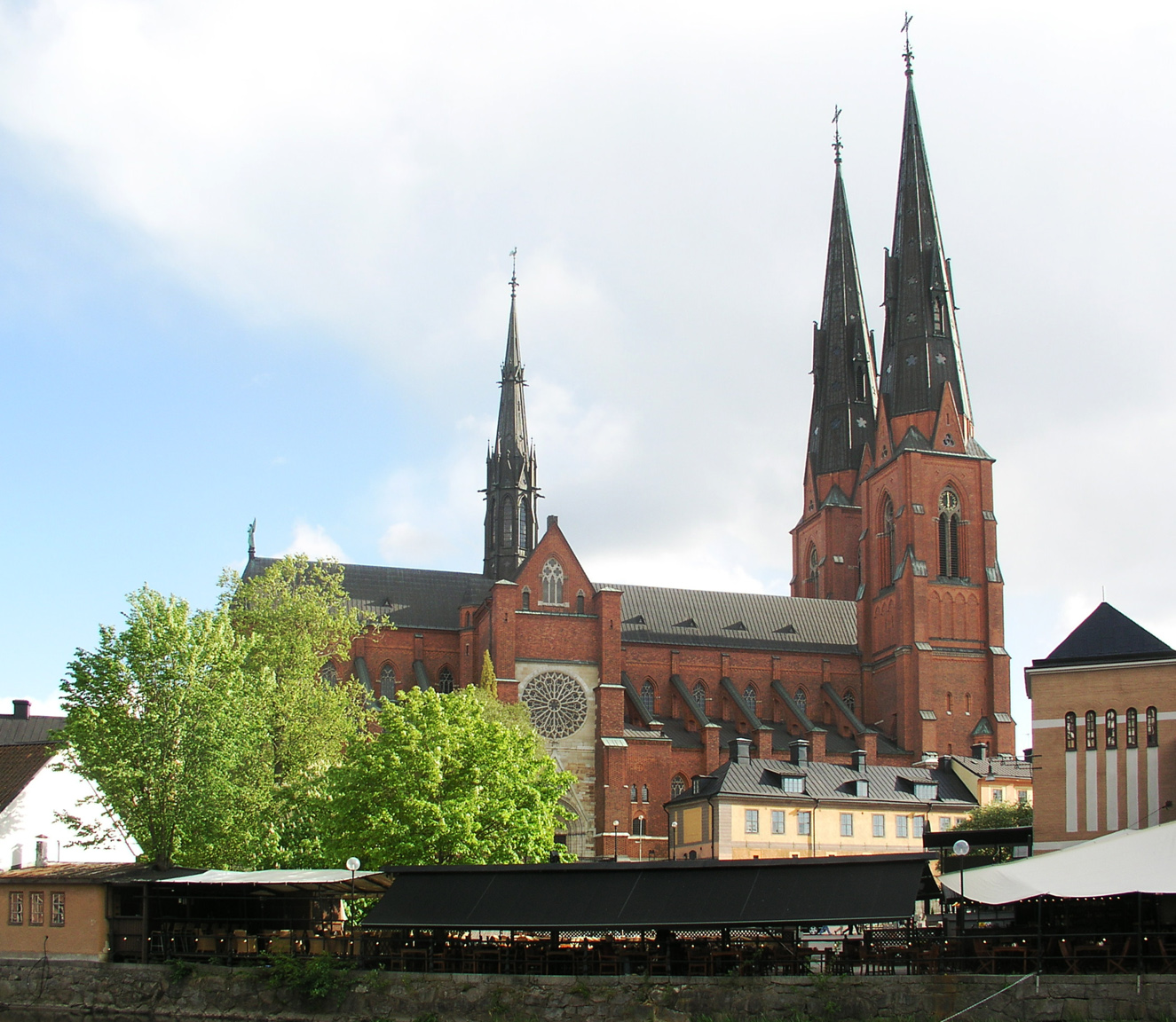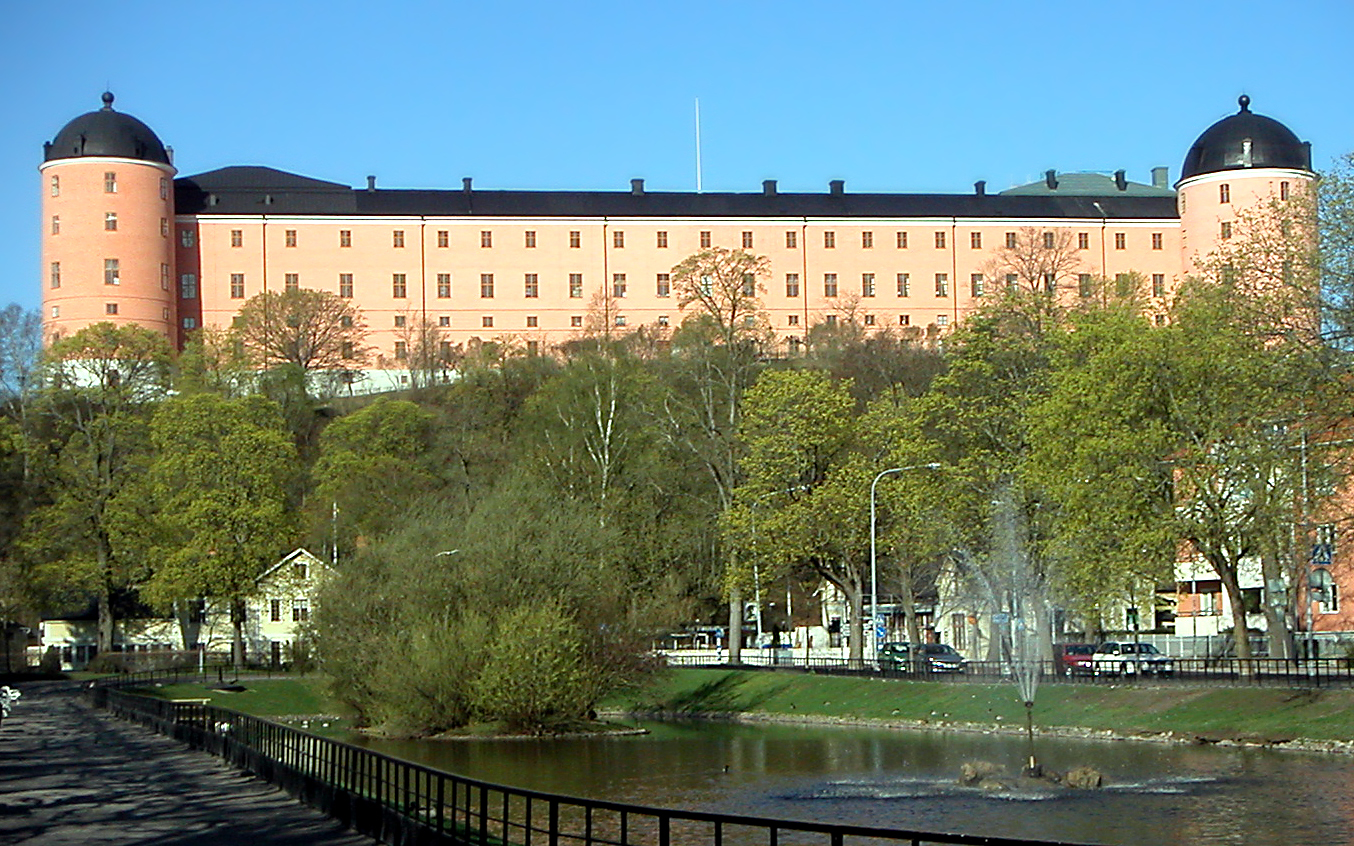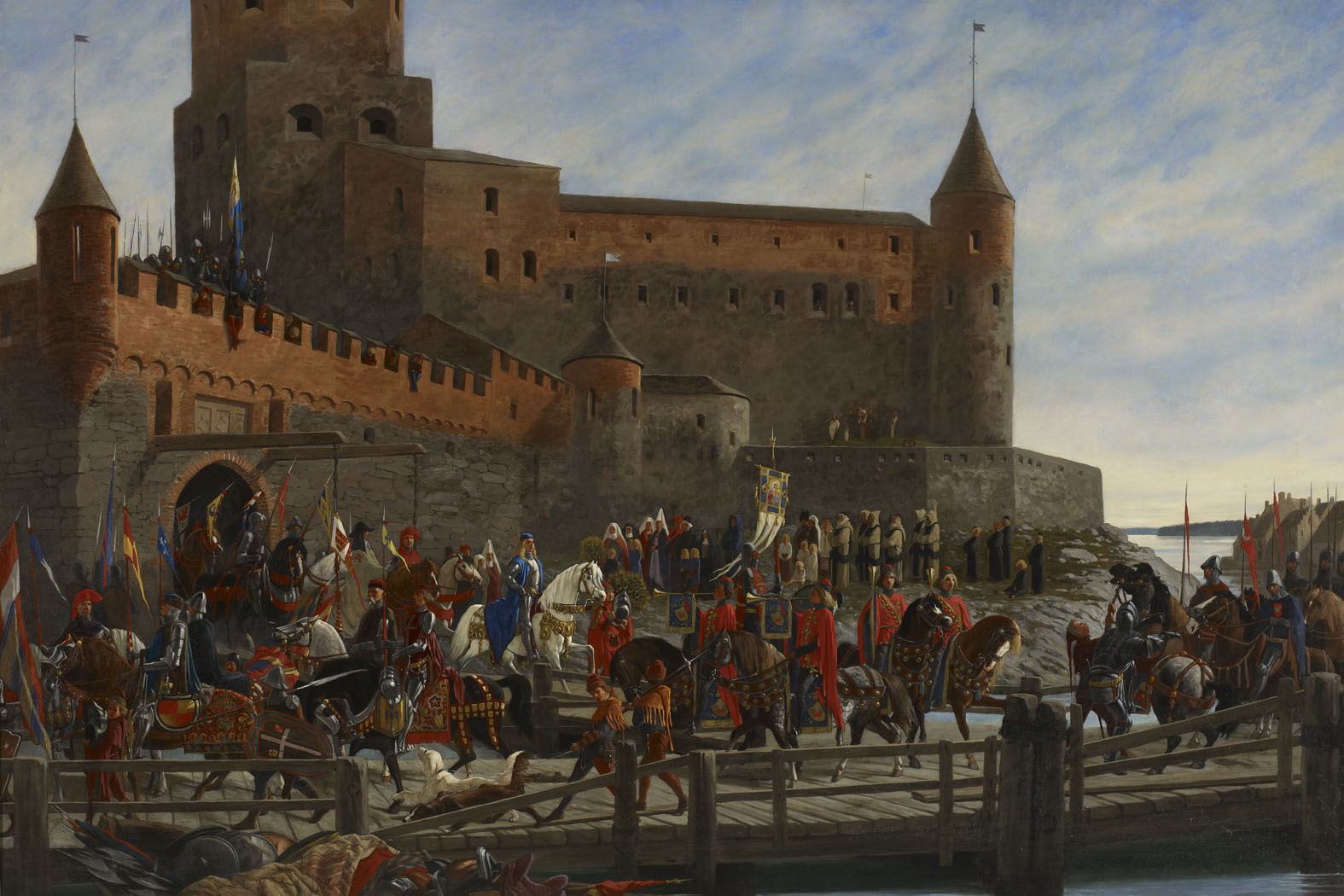|
Jakob Ulfsson
Jakob Ulvsson (1430s – spring 1521) was the archbishop of Uppsala and primate of the Roman Catholic Church of Sweden from 1469 to 1515. He was also the founder of Uppsala University in 1477. Biography Jakob Ulvsson came from a noble family background. He was born at Hacksta gård at Trögds härad in Uppland. He studied at the universities in Rostock (Bachelor of Arts in 1458/1459) and Paris ( magister 1460). He spent the years 1465–1470 in Rome and was meanwhile appointed Canon of Uppsala in 1465 and Archdeacon of Växjö in 1468. Despite King Karl Knutsson wanting to make one of his own relatives Archbishop of Uppsala, Jakob Ulvsson was appointed archbishop by the pope in 1469 and ordained in Rome in 1470, after which he returned to Uppsala. In the conflicts between the Danish king Christian I of Denmark and the Swedish regent Sten Sture, Jakob took a mediating position, trying as far as possible to avoid open warfare, especially in Uppland. After Sten Sture' ... [...More Info...] [...Related Items...] OR: [Wikipedia] [Google] [Baidu] |
Archbishop Of Uppsala
The Archbishop of Uppsala (spelled Upsala until the early 20th century) has been the primate of Sweden in an unbroken succession since 1164, first during the Catholic era, and from the 1530s and onward under the Lutheran church. Historical overview There have been bishops in Uppsala from the time of Swedish King Ingold the Elder in the 11th century. They were governed by the archbishop of Hamburg-Bremen until Uppsala was made an archbishopric in 1164. The archbishop in Lund (which at that time belonged to Denmark) was declared primate of Sweden, meaning it was his right to select and ordain the Uppsala archbishop by handing him the pallium. To gain independence, Folke Johansson Ängel in 1274 went to Rome and was ordained directly by the pope. This practice was increasing, so that no Uppsala archbishop was in Lund after Olov Björnsson, in 1318. In 1457, the archbishop Jöns Bengtsson (Oxenstierna) was allowed by the pope to declare himself primate of Sweden. Uppsala (t ... [...More Info...] [...Related Items...] OR: [Wikipedia] [Google] [Baidu] |
Rome
Rome (Italian language, Italian and , ) is the capital city and most populated (municipality) of Italy. It is also the administrative centre of the Lazio Regions of Italy, region and of the Metropolitan City of Rome. A special named with 2,746,984 residents in , Rome is the list of cities in the European Union by population within city limits, third most populous city in the European Union by population within city limits. The Metropolitan City of Rome Capital, with a population of 4,223,885 residents, is the most populous metropolitan cities of Italy, metropolitan city in Italy. Rome metropolitan area, Its metropolitan area is the third-most populous within Italy. Rome is located in the central-western portion of the Italian Peninsula, within Lazio (Latium), along the shores of the Tiber Valley. Vatican City (the smallest country in the world and headquarters of the worldwide Catholic Church under the governance of the Holy See) is an independent country inside the city boun ... [...More Info...] [...Related Items...] OR: [Wikipedia] [Google] [Baidu] |
People From Enköping Municipality
The term "the people" refers to the public or common mass of people of a polity. As such it is a concept of human rights law, international law as well as constitutional law, particularly used for claims of popular sovereignty. In contrast, a people is any plurality of persons considered as a whole. Used in politics and law, the term "a people" refers to the collective or community of an ethnic group or nation. Concepts Legal Chapter One, Article One of the Charter of the United Nations states that "peoples" have the right to self-determination. Though the mere status as peoples and the right to self-determination, as for example in the case of Indigenous peoples (''peoples'', as in all groups of indigenous people, not merely all indigenous persons as in ''indigenous people''), does not automatically provide for independent sovereignty and therefore secession. Indeed, judge Ivor Jennings identified the inherent problems in the right of "peoples" to self-determination, as i ... [...More Info...] [...Related Items...] OR: [Wikipedia] [Google] [Baidu] |
Year Of Birth Unknown
A year is a unit of time based on how long it takes the Earth to orbit the Sun. In scientific use, the tropical year (approximately 365 solar days, 5 hours, 48 minutes, 45 seconds) and the sidereal year (about 20 minutes longer) are more exact. The modern calendar year, as reckoned according to the Gregorian calendar, approximates the tropical year by using a system of leap years. The term 'year' is also used to indicate other periods of roughly similar duration, such as the lunar year (a roughly 354-day cycle of twelve of the Moon's phasessee lunar calendar), as well as periods loosely associated with the calendar or astronomical year, such as the seasonal year, the fiscal year, the academic year, etc. Due to the Earth's axial tilt, the course of a year sees the passing of the seasons, marked by changes in weather, the hours of daylight, and, consequently, vegetation and soil fertility. In temperate and subpolar regions around the planet, four seasons ar ... [...More Info...] [...Related Items...] OR: [Wikipedia] [Google] [Baidu] |
List Of Archbishops Of Uppsala
This article lists the archbishops of Uppsala. Before the Reformation * 1164–1185: Stefan * 1185–1187: Johannes * 1187–1197: Petrus * 1198–1206: Olov Lambatunga * 1207–1219: Valerius * 1219 (1224)–1234: Olov Basatömer * 1236–1255: Jarler * 1255–1267: Lars * 1274–1277: Folke Johansson Ängel * 1278–1281: Jakob Israelsson * 1281–1284: Johan Odulfsson (not ordained) * 1285–1289: Magnus Bosson * 1289–1291: Johan * 1292–1305: Nils Allesson * 1308–1314: Nils Kettilsson * 1315–1332: Olov Björnsson * 1332–1341: Petrus Filipsson * 1341–1351: Heming Nilsson * 1351–1366: Petrus Torkilsson * 1366–1383: Birger Gregersson * 1383–1408: Henrik Karlsson * 1408–1421: Jöns Gerekesson (''Johannes Gerechini'') * 1421–1432: Johan Håkansson * 1432–1438: Olov Larsson (''Olaus Laurentii'') * 1433–1434: Arnold of Bergen (not ordained) * 1438–1448: Nicolaus Ragvaldi * 1448–1467: Jöns Bengtsson Oxenstierna * 1468–1469: Tor ... [...More Info...] [...Related Items...] OR: [Wikipedia] [Google] [Baidu] |
Mariefred Charterhouse
Mariefred Charterhouse, sometimes referred to as Gripsholm Charterhouse (, or ''Pax Mariae''), was a Carthusian monastery, or charterhouse, in the present town of Mariefred in Södermanland, Sweden, to which it gave its name; before the building of the monastery the place was known as Gripsholm. It was the only Carthusian monastery in Scandinavia, and one of the last monasteries established in Sweden before the Reformation The Reformation, also known as the Protestant Reformation or the European Reformation, was a time of major Theology, theological movement in Western Christianity in 16th-century Europe that posed a religious and political challenge to the p .... History The establishment of a Carthusian monastery in Sweden was brought about by the efforts of Jakob Ulvsson, Archbishop of Uppsala, and Kort Rogge, Bishop of Strängnäs, who in 1493 persuaded Sten Sture the elder, Regent of Sweden, to have the monks Fikke Dyssin and Johannes Sanderi together with two lay b ... [...More Info...] [...Related Items...] OR: [Wikipedia] [Google] [Baidu] |
Pope Sixtus IV
Pope Sixtus IV (or Xystus IV, ; born Francesco della Rovere; (21 July 1414 – 12 August 1484) was head of the Catholic Church and ruler of the Papal States from 9 August 1471 until his death in 1484. His accomplishments as pope included the construction of the Sistine Chapel and the creation of the Vatican Library. A patron of the arts, he brought together the group of artists who ushered the early Renaissance into Rome with the first masterpieces of the city's new artistic age. Sixtus created the Spanish Inquisition through the Papal bull ''Exigit Sinceræ Devotionis'' (1478), and annulled the Pontifical decrees of the Council of Constance. He was noted for his nepotism and was personally involved in the infamous Pazzi conspiracy, a plot to remove the Medici family from power in Florence. Early life Francesco was a member of the Della Rovere family, a son of Leonardo Beltramo di Savona della Rovere and Luchina Monteleoni. He was born in Celle Ligure, a town near S ... [...More Info...] [...Related Items...] OR: [Wikipedia] [Google] [Baidu] |
Sten Sture The Elder
Sten Sture the Elder (; 1440 – 14 December 1503) was a Swedish statesman and regent of Sweden from 1470 to 1497 and again from 1501 to 1503. As the leader of the victorious Swedish separatist forces against the royal unionist forces led by Denmark, Danish king Christian I of Denmark, Christian I during the Battle of Brunkeberg in 1471, he weakened the Kalmar Union considerably and became the effective ruler of Sweden as Lord Regent for most of his remaining life. Background In contemporary sources he is alternatively referred to as ''Sten Gustavsson'' or ''Herr Sten'' ''(Lord Sten)''; the practice of using noble family names as part of a personal name was not yet in use in Sweden at the time. He was born around 1440, the son of Gustav Anundsson of the Sture family and Birgitta Stensdotter Bielke, half-sister of the future Charles VIII of Sweden, Charles VIII. The Sture family was one of the high-ranking noble families of the time, though only distantly related to the royal hou ... [...More Info...] [...Related Items...] OR: [Wikipedia] [Google] [Baidu] |
Christian I Of Denmark
Christian I ''(Christiern I)'' (February 1426 – 21 May 1481) was a German noble and Scandinavian monarch under the Kalmar Union. He was king of Denmark (1448–1481), King of Norway, Norway (1450–1481) and King of Sweden, Sweden (1457–1464). From 1460 to 1481, he was also duke of Schleswig (within Denmark) and count (after 1474, duke) of Duchy of Holstein, Holstein (within the Holy Roman Empire). He was the first king of the House of Oldenburg. In the power vacuum that arose following the death of Christopher of Bavaria, King Christopher without a direct heir in 1448, Sweden elected Karl Knutsson king with the intent to reestablish the union under a Swedish king. Karl was elected king of Norway in the following year. However the House of Schauenburg, counts of Holstein made the Danish Privy Council appoint Christian as king of Denmark. His subsequent accessions to the thrones of Norway (in 1450) and Sweden (in 1457) restored the unity of the Kalmar Union for a short ... [...More Info...] [...Related Items...] OR: [Wikipedia] [Google] [Baidu] |
Uppsala
Uppsala ( ; ; archaically spelled ''Upsala'') is the capital of Uppsala County and the List of urban areas in Sweden by population, fourth-largest city in Sweden, after Stockholm, Gothenburg, and Malmö. It had 177,074 inhabitants in 2019. Located north of the capital Stockholm, it is also the seat of Uppsala Municipality. Since 1164, Uppsala has been the ecclesiology, ecclesiastical centre of Sweden, being the seat of the Archbishop of Uppsala, Archbishop of the Church of Sweden. Uppsala is home to Scandinavia's largest cathedral – Uppsala Cathedral, which was the frequent site of the coronation of the Swedish monarch until the late 19th century. Uppsala Castle, built by King Gustav I of Sweden, Gustav Vasa, served as one of the royal residences of the Swedish monarchs, and was expanded several times over its history, making Uppsala the secondary capital of Sweden during its Swedish Empire, greatest extent. Today, it serves as the residence of the Governor of Uppsala County ... [...More Info...] [...Related Items...] OR: [Wikipedia] [Google] [Baidu] |
Charles VIII Of Sweden
Karl Knutsson Bonde ( 1408–1470), also known as Charles VIII and called Charles I in Norwegian contexts, was King of Sweden (1448–1457, 1464–1465 and 1467–1470) and King of Norway (1449–1450). He rose in Swedish politics because Erik of Pomerania was unpopular and became regent after a rebellion by Engelbrekt Engelbrektsson. He held powerful posts, notably in Finland, where he acted semi-independently. After King Christopher's death in 1448, Karl was elected king of Sweden and briefly king of Norway (1449–1450), but was forced to relinquish the latter to Christian I of Denmark. His rule faced opposition from the nobility and church, especially amid war with Denmark from 1451. His consolidation of power alienated key factions like the Oxenstierna and Vasa families, leading to growing resistance that resulted in two rebellions, in 1457 and 1464. Early life Karl Knutsson Bonde was born in October 1408 or 1409, at Ekholmen Castle, the son of Knut Tordsso ... [...More Info...] [...Related Items...] OR: [Wikipedia] [Google] [Baidu] |







